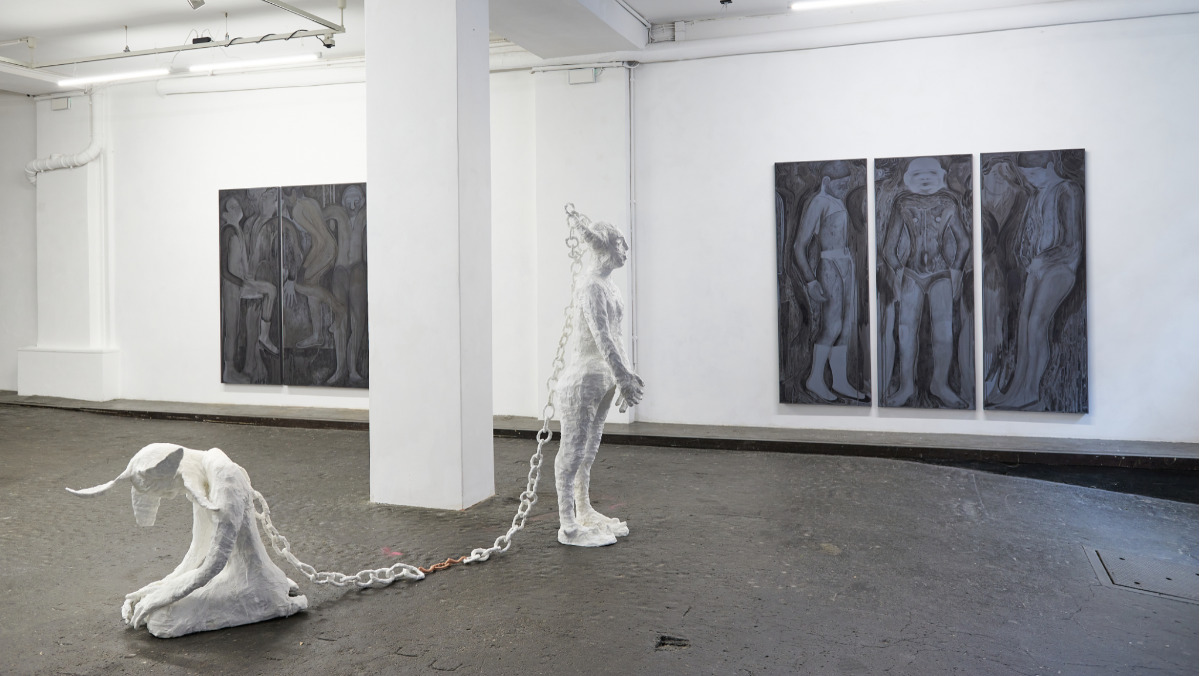
For a long time, I deemed words to be objectively true. This stemmed from the narrow idea of language as merely the equivalent of translated information, which can be conveyed through speech. Growing up with a rather inflexible and literal way of thinking and communicating, the abstract dimension of language has always been complicated for me. It’s not that I no longer value words, but through personal experience and literature, I’ve realized that they often demand significant efforts to decode. Within the fields of literary studies and philosophy, it has long been understood that hermeneutic attempts offer a variety of possible readings, from which one can choose and act accordingly. There is never just one meaning; interpretation opens pathways to first understand, and then respond. In this sense, interpretation itself becomes a fragile guide for action, shaping how one engages with the world. It is crucial to stress that this is not a process free of power and violence: Who has the option to be heard? Who decides what is considered the right interpretation (e.g. gaslighting)? Who establishes dominance – for example, by interrupting or being dismissive?
Eliza Wagener and Anna Bochkova’s exhibition takes as its starting point the assumption that, within the medium of language, communication is never technically certain and has a strong tendency to fail. But if even the best attempts of interpretation cannot ensure a certainty of understanding, what alternative remains? The title of their exhibition, “Die Sprache der Vögel”, refers to the French concept la langue des oiseaux. Traditionally associated with alchemist traditions and psychoanalysis, it designates a symbolic and playful mode of language where meaning emerges through sound similarities, wordplay, and hidden correspondences. Rather than focusing on straightforward communication, it points to a sensual and interpretive approach in which words and gestures can be taken apart, recombined, and reimagined to reveal unexpected meanings.
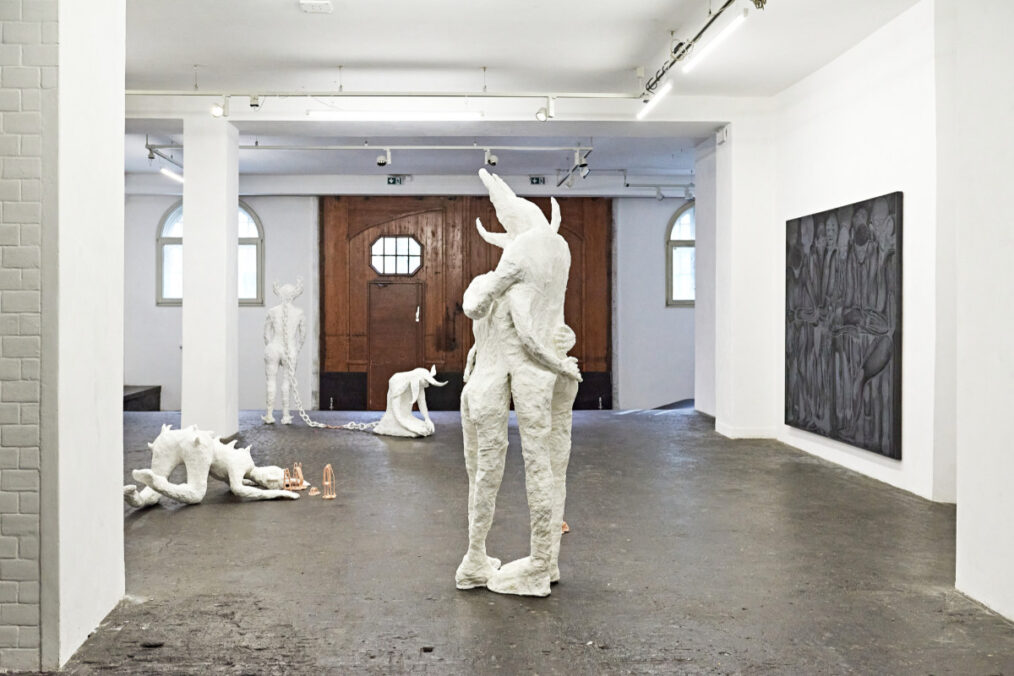
It is precisely this immanent contingency of language that their works take as a starting point, offering gestures and constellations of figures as another mode of communication. This becomes apparent upon entering the space, where Anna Bochkova’s sculpture “Bounding” (2025) seemingly greets visitors with its head held high, almost as if in acknowledgment of their presence. The figurine has its hands entangled in front of its crotch. A chain is hanging from its two horns, connecting to its counterpart seated on the floor, hands resting on its knees, head bowed. Even if visitors might see its posture and gaze as a sign of welcome, the figure’s true intent remains concealed: Its stance might suggest an interaction, yet its purpose or desire is deliberately ambiguous.
One theme that Bochkova investigates in her work is migration and its effects on both individuals and communities. Her figurative constellations–altogether there are three in the show– appear in pairs. While the first is positioned near the entrance, the remaining ones are placed close together in the center of the space. Against the cold stone floor, moments of connection unfold: one pair embraces, another inspects or plays. While some figures face each other and others turn away, all are linked in subtle relational networks that invite viewers to read gestures as a form of dialogue. In “Bounding”, although the two figures turn in opposite directions, they remain connected by a chain, creating an ambiguous relationship that is simultaneously comforting and burdensome. The chain itself functions as a direct form of possibly involuntary communication, physically manifesting connection and interdependence.
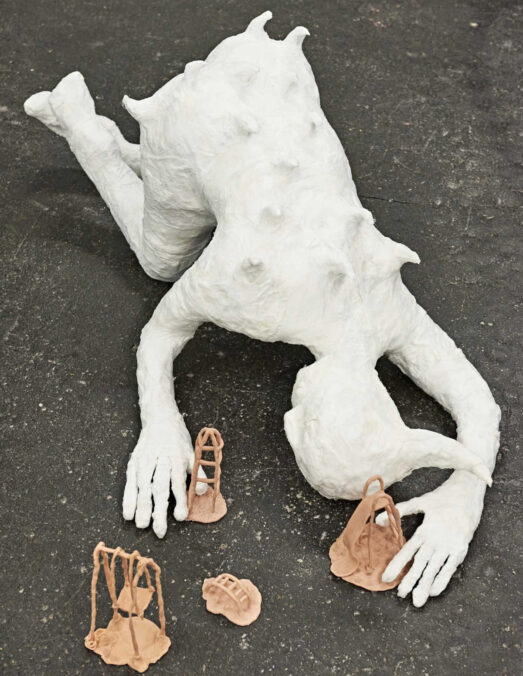

Although the dimensions, limb placement, and facial expressions of her protagonists are close to human anatomy, Bochkova’s figures remain abstract. Despite glossy highlights such as the shimmering pearls above their eyelids, her sculptures retain a raw surface, which the artist created by mixing cotton wool with glue. While most of her protagonists are held in a monochromatic white, some singular pieces, such as in the chain, differ in color: instead of white, they have a nudeish color–close to Bochkova’s own skin tone– and are made of polymer clay, subtly referencing an autobiographical perspective.
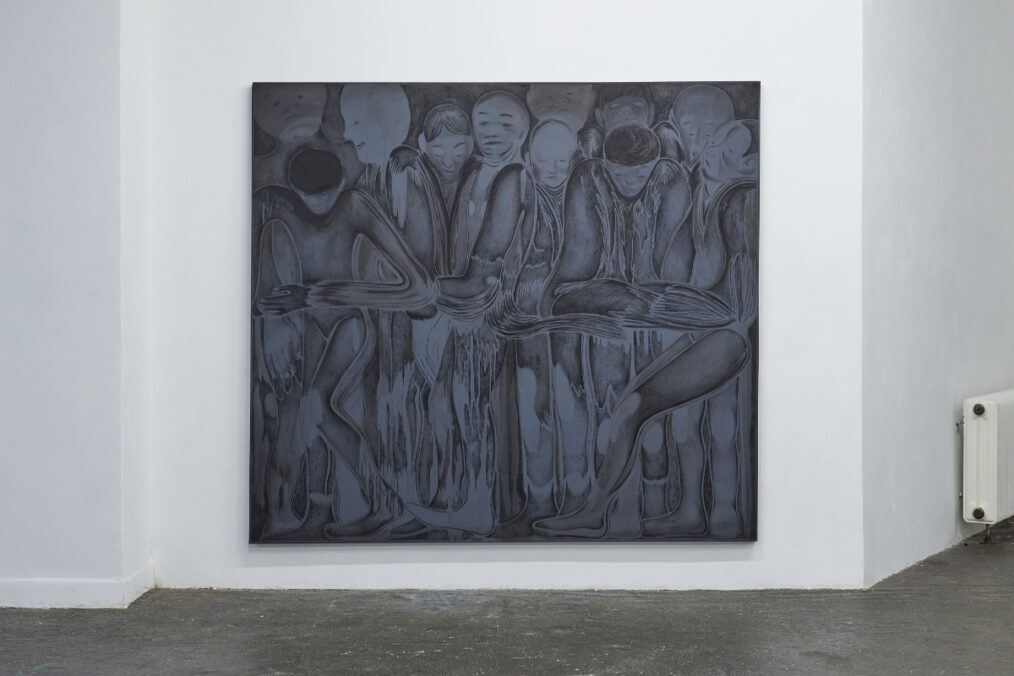
Surrounding these scenes of tender connections, Eliza Wagener’s large-format paintings such as “Untitled (Do Not Bend!)” (2025), depict carefully staged groups of people. The motifs she paints are rooted in her observations of public spaces, particularly restless places like train stations, crowded busses, or other places of public encounter. Filling the canvas with groups of figures, each protagonist has a distinct facial expression, hairstyle, and pose, yet together they form a cohesive ensemble. Though the figures do not overtly interact, the composition evokes internal harmony, unified through smooth bluish-grey and black strokes and a careful balance of light and dark that establishes a subtle rhythm. Working with a monochromatic palette for this body of work, Wagener explains, reduces decisions and allows her to concentrate on drawing and composition.
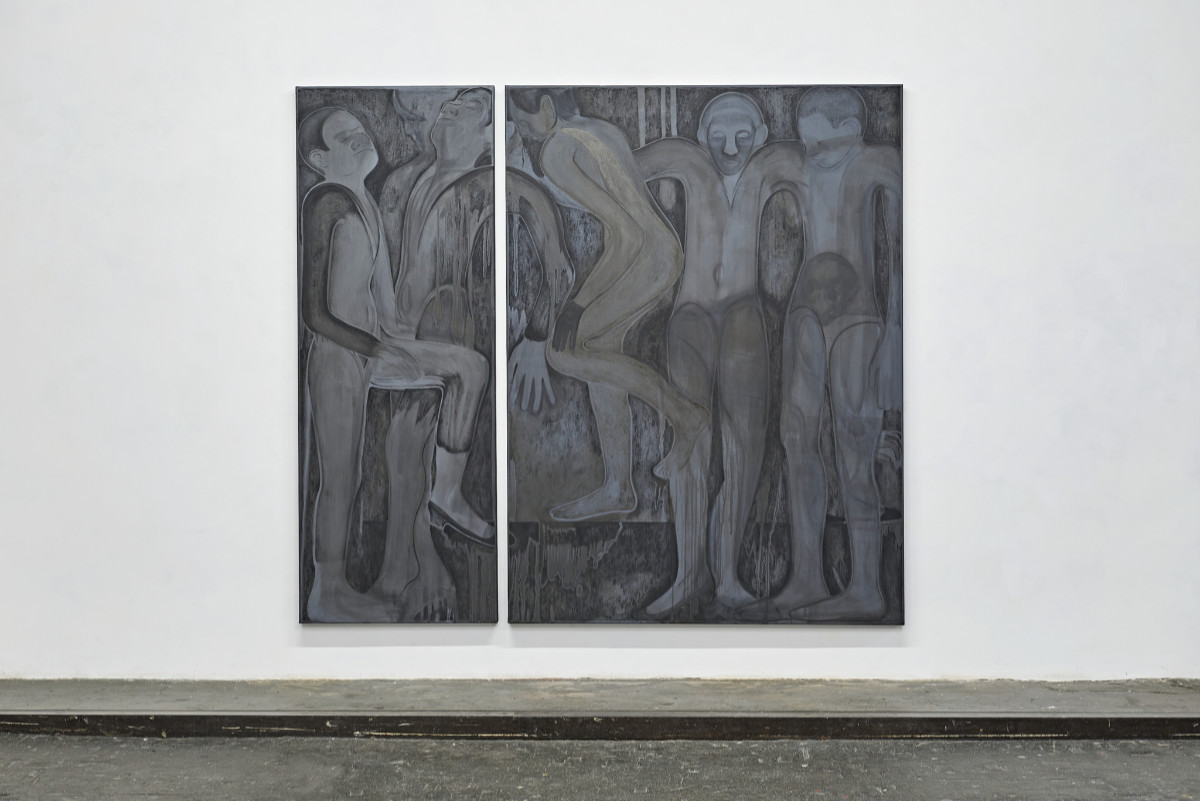
Wagener is particularly interested in the notion of gestures. The gestures of the figures suggest a dynamic form of assembly, where they interact through movement rather than direct communication, negotiating space, asserting presence, and revealing social relationships within the group. Each figure holds a tension of connection and autonomy, hinting at bonds that are both cooperative and ambivalent. Rendering them on a large scale, Wagener allows her figures to claim and inhabit the space both within the frame and in the room. The deep tones of black reflect the lighting of the exhibition, while the triptych format offers viewers a harmonic structure, letting the works resonate with the room as a whole. Wagener emphasizes physicality, spatial negotiation, and subtle relational dynamics, whereas Bochkova constructs a metaphorical shell of care and vulnerability with cotton, letting the material itself serve as a means of expression beyond words.

Their artistic practices extend beyond the production of artworks into workshops and the creation of shared social spaces. One thing that stayed with me when I spoke to Wagener and Bochkova was: “Violence is all around, but wherever I can create an environment I intend to end it.” Explicitly referencing the potential violence embedded in language, they introduce artistic production as a form of communication that engages with questions of material, space, and relationality. By populating the space with carefully interacting protagonists, they create a social room, a kind of stage where emotions and dynamics can be explored in nonverbal ways. Here, artistic practice becomes a mode of refuge and healing, a space to articulate what cannot be spoken and to forge connections that resist the alienation of violence. Ultimately, in both Wagener’s and Bochkova’s work, gestures, materials, and spatial arrangements serve as a form of language in a way to communicate, negotiate and connect.
Exhibition: Eliza Wagener, Anna Bochkova – Die Sprache der Vögel
Exhibition duration: 03.07.2025 – 13.07.2025
Address and contact:
Westwerk.
Admiralitätstraße 74, 20459 Hamburg
www.westwerk.org





